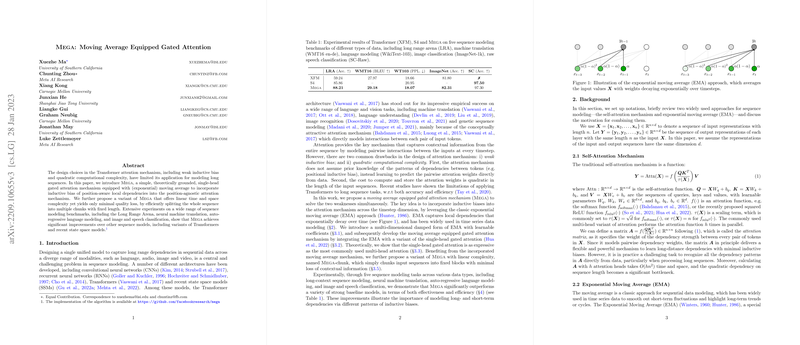Insights on "Mega: Moving Average Equipped Gated Attention"
The paper "Mega: Moving Average Equipped Gated Attention" explores the limitations inherent in the prevalent attention mechanism within Transformers, specifically its weak inductive bias and quadratic computational complexity. These constraints have been significant hurdles in effectively modeling long sequence data across diverse modalities, including text, audio, and images.
The proposed solution, Mega, introduces a theoretically grounded, single-head gated attention mechanism enriched by an exponential moving average (EMA). This novel model integrates inductive bias for position-aware local dependencies into the typically position-agnostic attention mechanism of Transformers. The integration of EMA offers the dual advantage of capturing local dependencies that decay exponentially over time and simplifying computational characteristics, allowing Mega to offer linear time and space complexity in some configurations with a minimal loss of quality.
Key Contributions
- Single-head Gated Attention: Mega replaces the conventional multi-head attention with a single-head gated mechanism, simplifying model architecture while maintaining comparable expressive power. Theoretical justifications affirm that this simplification retains the effectiveness of multi-head setups.
- Exponential Moving Average (EMA) Integration: By embedding multi-dimensional damped EMA, Mega enhances the inductive bias, allowing for smoother transitions and contextual encoding of input sequences, which is particularly beneficial for sequential data applications.
- Computational Efficiency: Mega's architecture allows for a variant, termed Mega-chunk, that divides input sequences into fixed-length chunks, achieving linear complexity. This variant maintains competitive performance despite reduced computational demands.
Empirical Evaluation and Results
The efficacy of Mega is validated through comprehensive experiments across diverse sequence modeling benchmarks like the Long Range Arena, neural machine translation, LLMing, and image and speech classification tasks. The results demonstrate that Mega consistently outperforms both classic Transformer models and recent state space models. Notably, Mega achieves a balance of accuracy and efficiency, with significant improvements in tasks with extended sequence lengths—a persistent challenge in deep learning.
The experiments on Long Range Arena showcase Mega's superior accuracy across various tasks, particularly highlighting its adaptation to long-context sequences. Similarly, the model performs robustly in neural machine translation and LLMing tasks, contending effectively with state-of-the-art models and exceeding them in terms of perplexity on language data.
Implications and Future Directions
The integration of EMA in attention mechanisms presents a promising direction for enhancing Transformers, especially for applications necessitating long-range sequence modeling. By aligning attention computations with more grounded inductive biases and offering adaptable complexity, Mega opens pathways for more efficient and effective architectures.
Practically, models like Mega can spur advancements in fields requiring the handling of extensive and diverse data sequences, such as natural language processing, bioinformatics, and large-scale image processing.
Future Research Directions:
- Extend Mega's principles to broader multi-modal sequence modeling.
- Optimize data augmentation techniques specifically for models employing integrated EMA.
- Explore the applicability of Mega's gated mechanisms in reinforcement learning and other domains requiring causal sequence modeling.
The Mega model, by navigating Transformer limitations and expanding computational strategies, underscores a significant leap in effective sequence modeling through integrated inductive bias and complex simplicity. As such, it holds great promise for future AI developments in sequence-intensive domains.
